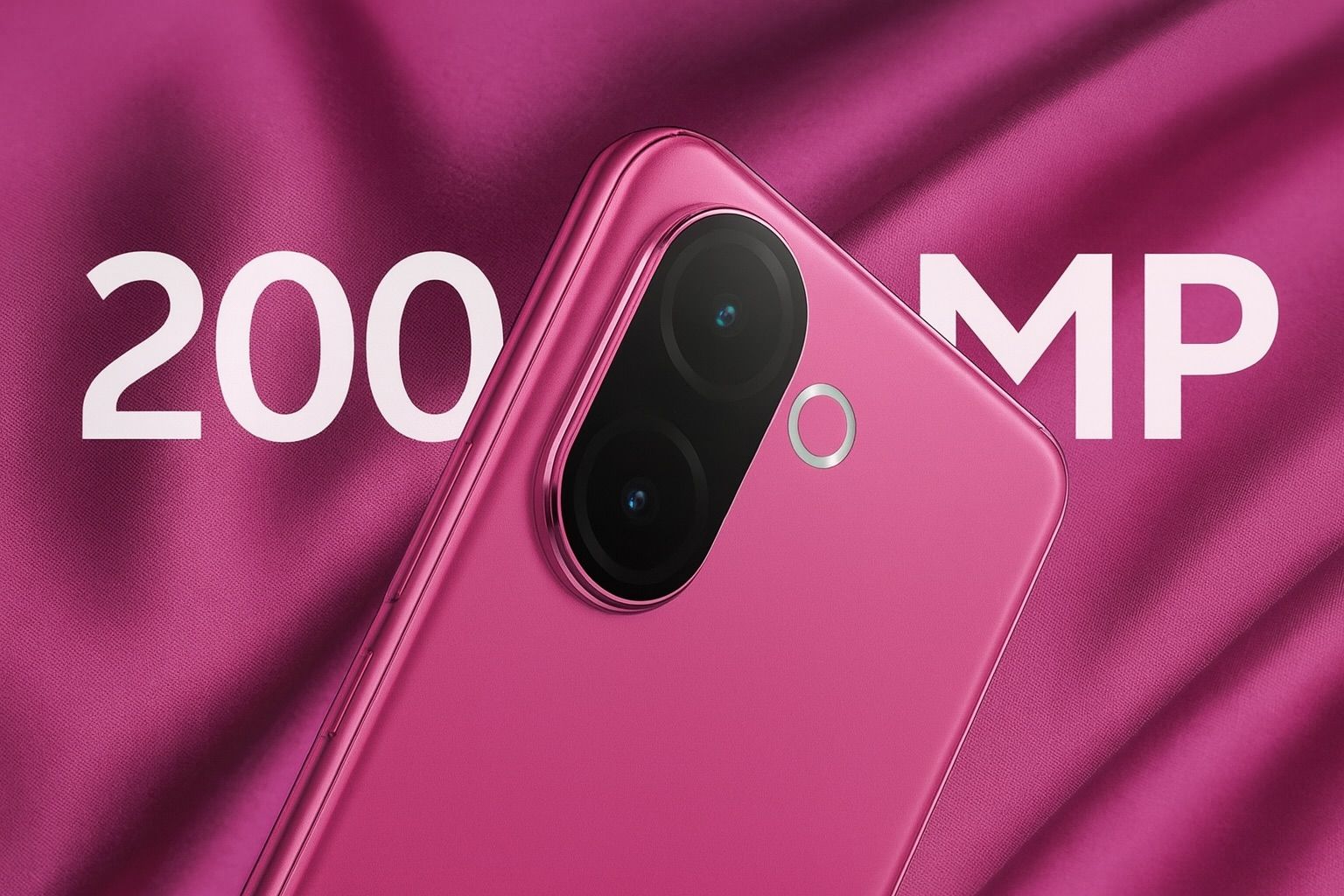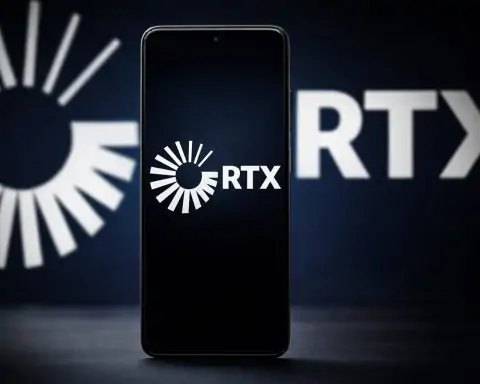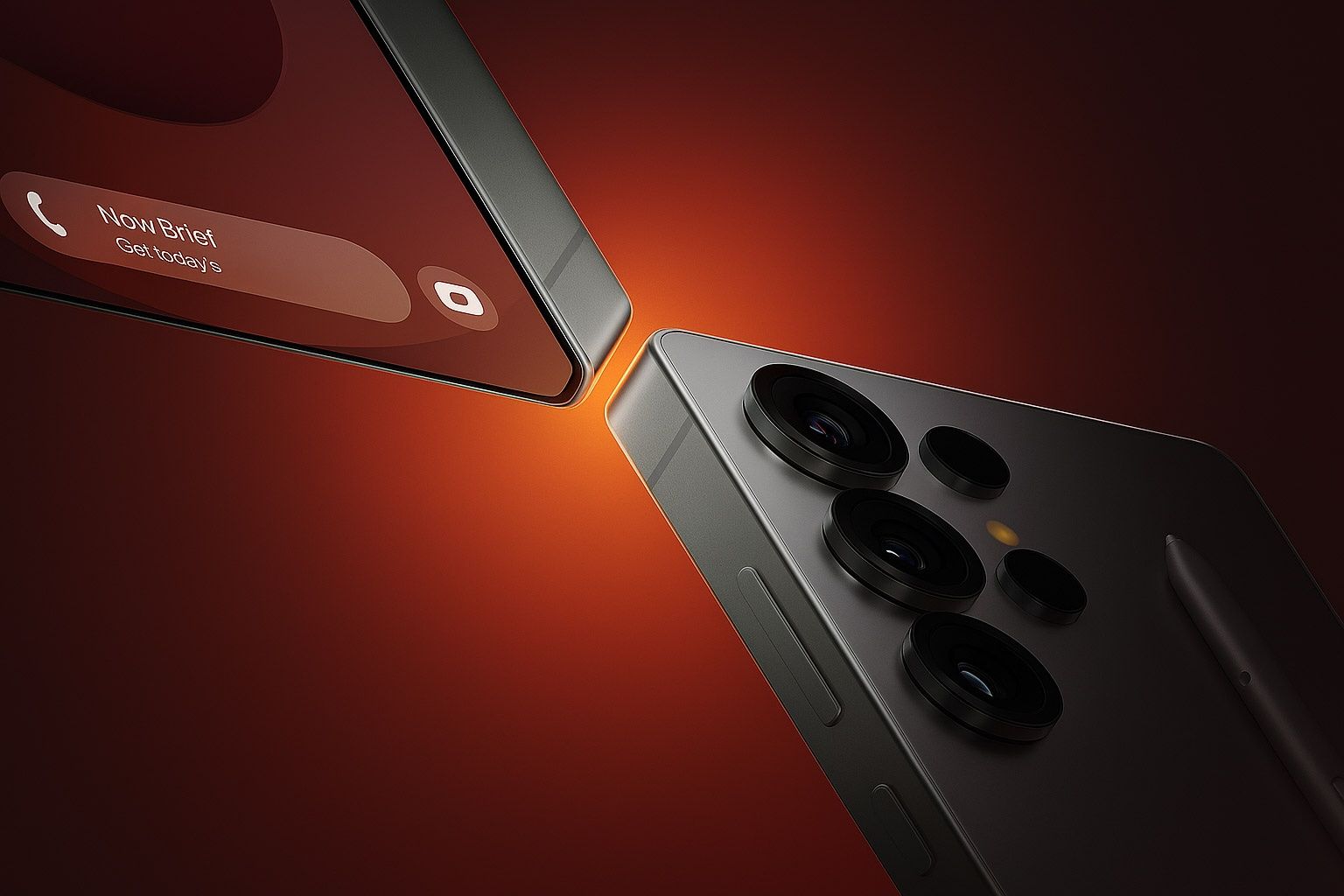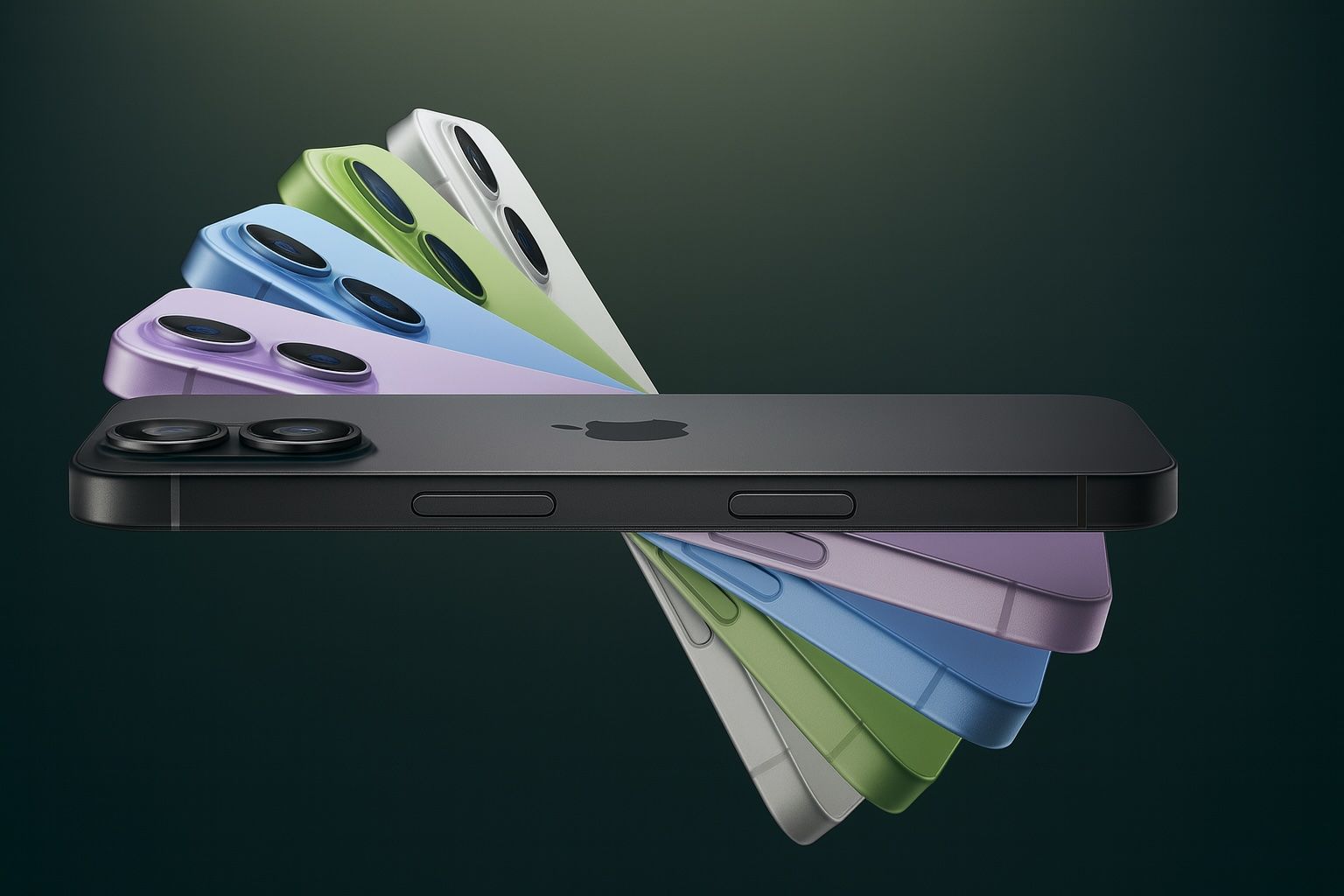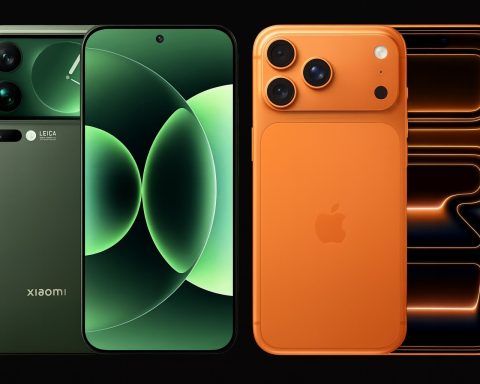- Launch & Hype: Vivo is set to launch the V60e 5G in India on October 7, 2025, touting a 200MP main camera and a massive 6,500 mAh battery in a slim chassis [1] [2]. The company has been teasing the design and features on its website and social media to build excitement [3].
- Design & Build: The V60e’s design closely mirrors the Vivo V60 flagship with a curved frame and vertically stacked camera module (resembling an iPhone-style layout) [4]. However, it reportedly uses a glossy plastic back to keep weight down [5]. In contrast, the older V50e 5G came with a premium glass back and a more traditional camera layout similar to its V50 siblings [6]. Both phones boast rugged IP68/IP69 dust and water resistance for durability [7] [8].
- Display: Both models feature a 6.77-inch FHD+ AMOLED display with a smooth 120 Hz refresh rate [9]. The new V60e is expected to reach up to 1,800 nits peak brightness, an ultra-bright panel for sunlight visibility [10]. The V50e’s screen was also praised for its vibrant colors and high brightness (around 1300–1800 nits peak) and comes protected by Diamond Shield Glass for extra toughness [11] [12].
- Performance: Surprisingly, the V60e 5G uses the same MediaTek Dimensity 7300 processor as the V50e [13]. This 4nm octa-core chipset delivered solid mid-range performance in the V50e – smooth for daily tasks and even capable of gaming with some settings tweaks [14] [15]. Both phones offer 8 GB RAM (with up to 12 GB option on the V60e) and up to 256 GB storage, so raw performance and multitasking remain similar [16] [17]. Each runs Vivo’s Funtouch OS (Android-based); the V50e launched on Android 15 with a promise of 3 years of updates [18], and the V60e should ship with the latest Android (likely Android 15) and comparable update support.
- Battery & Charging: Vivo is “beating physics” by fitting a huge 6,500 mAh battery in the slim V60e [19] [20]. This is a significant jump from the V50e’s already large 5,600 mAh battery [21]. In practice, the V50e easily delivered all-day usage for most users and supports 90W fast charging for quick top-ups [22]. The V60e retains the 90W charging but with the bigger battery, meaning even longer endurance – potentially two-day battery life for light users – without sacrificing the thin design [23] [24]. (Vivo includes the 90W charger in-box for the V60e, according to reports [25].)
- Cameras: The headline upgrade is the V60e’s 200 MP Ultra HD primary camera with OIS (optical stabilization) [26]. This is a fourfold resolution jump from the V50e’s 50 MP main camera (which used a Sony IMX882 sensor with OIS) [27] [28]. The V60e’s camera is touted to enable exceptional detail and an 85 mm “close-up” portrait mode using in-sensor zoom, plus a special “AI Festival Portrait” mode for portraits [29]. Notably, Vivo has omitted a telephoto lens on both devices – the V60e achieves portrait zoom via that high-res sensor, while the V50e relied on digital zoom (both also include an 8 MP ultra-wide camera) [30] [31]. On the front, selfies are 50 MP on both phones with Vivo’s eye autofocus for sharp portraits [32] [33]. It’s worth mentioning that unlike the higher-end V-series models, the V60e lacks ZEISS branding on its camera system, despite the huge sensor upgrade [34]. This suggests the lens and color tuning might differ slightly from Vivo’s flagship imaging standards, but it still represents a major leap in raw hardware.
- Price & Value: The Vivo V60e 5G is expected to launch at around ₹28,749 for the base 8GB+128GB variant [35] [36]. Higher trims (8+256GB and 12+256GB) may cost roughly ₹30.7K and ₹32.7K respectively [37]. By comparison, the Vivo V50e debuted earlier in 2025 at ₹28,999 for 8+128GB [38], though it’s currently listed around ₹26,999 after some months on the market [39]. In essence, Vivo is pricing the V60e in the same mid-₹28–32K range, aiming to deliver more features for a similar price. The V60e will come in elegant new colors (Noble Gold and Elite Purple) as announced by Vivo [40], and will hit stores shortly after the October 7 launch in India. Global availability hasn’t been detailed yet, but Vivo often introduces such models to other Asian markets in the following months.
Design & Display Comparison
The Vivo V60e 5G brings an updated design language while maintaining the premium feel of the V-series. It inherits design cues from the standard Vivo V60 – including a curved-edge frame and a pill-shaped vertical camera module on the rear [41]. Vivo’s teasers and leaks show a sleek silhouette available in Elite Purple (a striking pink-purple hue) and Noble Gold, with a glossy finish [42] [43]. Interestingly, to accommodate the bigger battery without making the phone hefty, Vivo appears to have opted for a plastic back on the V60e [44]. While not as premium as glass, the plastic build helps keep the device extremely thin and light even with its large battery – a design feat Vivo is proudly marketing [45]. The camera layout is vertically aligned in the top corner with a subtle bump, echoing an iPhone 16/17-like style according to India Today Tech [46]. An LED ring flash sits beside the lenses, and overall the phone has a modern, minimal aesthetic.
By contrast, the Vivo V50e 5G (launched in April 2025) also sported a 6.77-inch display up front with curved edges, but its rear design was a bit different. The V50e’s camera module had a more traditional look (in line with the earlier Vivo V50 series), and reviewers noted it was minimalist and low-profile – the camera bump was subtle, avoiding a wobble on flat surfaces [47]. The big differentiator is materials: the V50e came with a glass back and matte-finish metal side rails, giving it a more premium hand-feel [48]. The V50e’s build was praised for being sleek, lightweight yet sturdy, with a refined gradient finish on the back [49]. Both phones carry official IP68 and IP69 ratings for dust and water resistance [50] [51], which is somewhat rare at this price point. This means they can handle full water submersion and even high-pressure water jets, adding peace of mind for durability.
In terms of display, both the V60e and V50e are very similar on paper: 6.77-inch AMOLED panels, 1080×2392 (Full HD+) resolution, and a smooth 120 Hz refresh rate for fluid scrolling [52]. The V50e’s screen was a highlight in its reviews – described as bright, vibrant and immersive, with HDR10+ support and wide viewing angles [53]. It also features Diamond Shield Glass protection, an ultra-tough glass that Vivo claims improves shatter resistance [54]. The touch sampling rate is high (300 Hz on V50e) making it very responsive [55]. Vivo provides different color calibration modes (Standard, Professional, Bright on V50e) to tune the display to your preference [56].
For the V60e, leaks indicate it uses an OLED panel likely of the same size and resolution, and Vivo has confirmed the 120Hz refresh remains [57]. The key improvement is in peak brightness: the V60e is expected to reach a blinding 1,800 nits peak brightness for vivid outdoor visibility [58]. (For context, that level rivals some flagships and ensures the screen stays readable even under harsh sunlight.) The V50e’s display was no slouch either – it was rated around 1,300 nits peak in official specs [59], though some tests and Vivo’s own claims suggest it could hit up to 1,800 nits as well [60]. In everyday use, both screens get plenty bright; users noted the V50e remained usable outdoors, only struggling with direct reflections occasionally [61]. Colors are punchy on both, and the large 6.8-inch canvas with slim bezels makes for an excellent media and gaming experience. In short, display quality is a strong suit for both phones, with the V60e likely matching or slightly exceeding the V50e’s already excellent screen (perhaps with improved brightness and the latest display glass technology).
Performance & Software: Same Brain, Newer Touches
One of the most surprising aspects of this generation refresh is that Vivo hasn’t upgraded the core processor – the V60e 5G runs on the MediaTek Dimensity 7300 chipset, the very same 5G-capable SoC powering the V50e [62]. The Dimensity 7300 is a modern 4nm octa-core chip (launched in 2024) with 4 performance cores (Cortex-A78 up to 2.5 GHz) and 4 efficiency cores (Cortex-A55 ~2.0 GHz) [63]. It’s paired with a Mali-G610 class GPU. In the Vivo V50e, this chip proved quite capable: day-to-day tasks run without hiccups, and even heavier apps and games are handled well for a mid-range device [64]. Benchmarks put its performance in the upper-midrange tier (around 670k in AnTuTu v10 according to Vivo) – not far off last year’s flagship-lite processors. Casual games and multitasking posed no issue on the V50e; only demanding 3D games required lowering some graphics settings to maintain smooth frame rates [65] [66]. Thermals on that 4nm chip are efficient, contributing to better battery life as well [67].
Given this, the V60e will deliver a very similar performance profile to the V50e. Multitaskers can breathe easy: both phones come with 8 GB LPDDR4X RAM standard, and Vivo’s software allows using some storage as Virtual RAM if needed. Notably, leaks suggest Vivo might offer a higher 12 GB RAM variant of the V60e for power users [68]. Storage options remain 128GB or 256GB UFS 2.2 on both; ample for most users, though expansion via microSD is not mentioned (V50e did not have a card slot, focusing on internal storage).
On the software front, the V50e launched with the latest available Android 15 (Funtouch OS 15 skin) earlier this year [69] [70]. Vivo committed to 3 years of major Android updates and 4 years of security patches for that device [71], meaning V50e owners should see updates through Android 18 eventually. The user interface on Funtouch OS 15 was praised for its refinement and rich features – it adopted Material You design elements from Android, offered extensive customization (themes, always-on display tweaks, etc.), and added some Vivo-specific enhancements while remaining smooth and fairly clean [72]. We expect the V60e 5G to ship with Funtouch OS 15 (or a newer 15.x/16 version) on top of Android (likely Android 15 as well, since Android 16 is only just releasing around the same time). Vivo will presumably extend a similar update policy to the V60e, which would be important for longevity in this price segment.
In practice, users upgrading from V50e to V60e won’t see a big difference in app speeds or interface – the experience should be virtually identical in responsiveness. One downside is that V60e doesn’t bring a newer chip, so it “is expected to share the same MediaTek Dimensity 7300 processor as the V50e 5G” [73]. This means no generational leap in CPU/GPU power. For some context, the main Vivo V60 (non-e) model uses a Snapdragon 7 Gen 3 chip for higher performance, but the V60e sticks to the Dimensity to hit a lower price point. That said, Dimensity 7300 is still a solid mid-range SoC in late 2025, and most users will find it sufficient. It also helps that Vivo’s optimization kept things smooth on the V50e – even heavy multitasking and high-refresh-rate usage didn’t bog it down [74]. Unless you are a hardcore mobile gamer or need cutting-edge silicon, the V60e’s performance should satisfy, just as the V50e’s did.
Connectivity and other hardware are comparable: Both phones support dual-5G, 4G VoLTE, Wi-Fi 6, Bluetooth, GPS and have USB-C ports. They also retain useful features like an in-display fingerprint scanner for quick unlocking [75]. Vivo has even kept the 3.5mm headphone jack on some of its mid-range phones in the past – it’s unconfirmed if the V60e has one (the V50e did not have a headphone jack, according to some sources, relying on USB-C audio or wireless). NFC for payments is likely included as well.
One small area of improvement could be software features: the V60e will benefit from Vivo’s latest OriginOS or Funtouch updates post-launch (interestingly, Vivo is planning to introduce its OriginOS globally on Oct 15 [76] [77], which might eventually come to these devices). Overall, when it comes to performance and software, the upgrade from V50e to V60e is evolutionary rather than revolutionary – largely the same engine is powering the experience, so expect a similarly “seamless… and low power consumption” daily performance [78] with no major speed boosts. The focus of this new model lies elsewhere, as we’ll see in battery and camera upgrades.
Battery Life & Charging: From All-Day to Two-Day?
Battery endurance was a strong suit of the Vivo V50e, and Vivo has doubled down on that strength with the V60e. The V50e packed a 5,600 mAh battery, already larger than typical mid-range phones, and coupled it with aggressive 90W fast charging. In reviews, the V50e comfortably delivered full-day battery life even for heavy users: for routine tasks (messaging, browsing, social media) users could end the day with charge to spare [79]. Screen-on times of 7-8 hours were attainable thanks to the efficient 4nm chip and software optimizations (Vivo’s Funtouch OS includes AI battery management that adapts background activity to save power [80]). Even gaming sessions didn’t drain it too quickly – for example, an hour of graphic-intensive gameplay might consume ~12-15% battery on V50e [81]. In short, battery performance on V50e was excellent, and with 90W charging, refilling the phone was very convenient. Vivo claims the fast charger can deliver a significant charge in just a few minutes (exact metrics aside, users report around 50% charge in ~20 minutes for similar capacity batteries, which is impressive). The V50e’s large battery and speedy charging meant less “range anxiety” – a key selling point for power users.
Now, the V60e 5G ups the ante to a whopping 6,500 mAh battery [82]. That is one of the largest batteries in any mainstream smartphone right now, especially notable given the phone’s slim profile. Vivo is effectively giving the V60e the endurance of a small tablet – expect multi-day battery life for moderate use. With ~16% more capacity than its predecessor, the V60e could likely push past 1.5 days to 2 days on a single charge for an average user. Even heavy users who stream video, play games, and keep the screen at 120Hz can expect longer runtime before reaching for the charger. Crucially, 90W FlashCharge support remains on the V60e [83]. Both devices use Vivo’s proprietary fast charging tech (via USB-C cable), and leaks say the V60e will include the compatible 90W charger in the box [84]. This means that despite the larger battery, charging times should remain very fast – likely around 30 minutes for a ~70% charge, and roughly 40-50 minutes for a full 100% charge (extrapolating from the V50e’s charging curve). In practical terms, a brief 10-minute charge could give many hours of use – perfect for top-ups before heading out.
What’s astonishing is that Vivo managed to keep the device slim while cramming such a battery. India Today quipped that Vivo is “once again beating physics” by fitting 6,500mAh into an “upcoming phone” that’s extremely thin and light [85]. We don’t have exact dimensions yet, but the V50e was about 8mm thick and 192g – the V60e might be slightly heavier, but if Vivo’s teaser is true, it shouldn’t be much more. The chassis design and perhaps a new battery technology (maybe a stacked battery or higher energy density cells) allow this capacity without a brick-like device.
Both phones also support USB-PD and other charging standards to some extent, but to get full 90W speed you’ll use Vivo’s charger. And both do not support wireless charging – understandable, as that feature is still rare in mid-range phones at this price.
To sum up, battery life is a big winner on the V60e. The V50e already “excelled in battery performance, offering all-day usage for most users while supporting fast-charging for quick top-ups” [86]. The V60e takes that further – it’s poised to be a battery champion in its class, likely one of the longest-lasting phones under ₹30K. For users who value endurance (think travelers, heavy media consumers, or just those who hate daily charging), the V60e presents a compelling upgrade. The only trade-off might be a negligible increase in weight, but given Vivo’s focus on keeping it light, it shouldn’t impact usability much.
Cameras: Giant Leap in Megapixels, Same Focus on Portraits
The camera department is where the Vivo V60e 5G makes headlines. Vivo has confirmed a 200 MP primary rear camera on the V60e – an eye-popping resolution usually seen only on some flagships or upper-mid phones, and a first for a Vivo phone in this price bracket [87] [88]. In fact, as the Economic Times noted, this could make the V60e “one of the first mid-range devices to offer such a high-resolution sensor” [89]. By comparison, the Vivo V50e (and even the higher-end V50) used a 50 MP main camera. So, what does this 200MP upgrade entail, and is it truly better?
Firstly, the sensor: While Vivo hasn’t specified the exact model, a 200MP sensor in mid-range is likely a Samsung ISOCELL or similar, with advanced pixel-binning. It will combine pixels (perhaps 16-to-1) to produce 12MP or 50MP images with improved light capture. This means sharper details, especially in good lighting, and potentially better digital zoom since cropping from 200MP still yields usable resolution. Vivo is heavily marketing the portrait capabilities of this camera. They claim the 200MP shooter with OIS enables an 85 mm equivalent “close-up portrait” mode [90]. Typically, 85mm is a classic focal length for portrait lenses – since the V60e lacks a telephoto lens, it likely uses the high-resolution sensor to crop in, simulating a 2x or 3x zoom for portraits without losing too much detail. There’s also mention of an “AI Festival Portrait” mode exclusive to this model, which presumably uses AI algorithms to enhance portrait shots (perhaps with special filters or lighting effects for festival scenes) [91].
The V50e’s camera, while lower resolution, was no slouch. It featured a 50MP Sony IMX882 sensor with an f/1.79 lens and Optical Image Stabilization [92]. Reviews found it to take detailed, well-exposed images in daylight with vibrant colors [93] [94]. The V50e’s imaging tended to lean on Vivo’s software optimizations (AI Scene detection, etc.) to maximize the relatively smaller megapixel count. Low-light performance was decent thanks to Night Mode, although naturally a 50MP sensor can only capture so much light – some noise and softness crept in very dark conditions [95]. Now, the V60e’s 200MP sensor should, in theory, improve low-light and detail dramatically by combining pixels. With OIS steadying longer exposures and AI Night Mode, we expect significantly clearer night shots from the V60e. However, one caveat: Vivo’s ZEISS optics and T* lens coatings that appear on higher-end V-series and X-series might be absent here. Indeed, NotebookCheck observed that “the camera features optical image stabilization, but the Zeiss branding is missing” on the V60e [96]. So, while the hardware is impressive, the lens and image processing might be tuned slightly differently than, say, the main Vivo V60 (which likely has Zeiss tuning on its 50MP camera). Still, for most users, a 200MP camera on a mid-range phone is an attention-grabber and likely a major upgrade in capability.
Both the V60e and V50e come with a secondary 8 MP ultra-wide camera (around 116° field of view on V50e) [97]. This is useful for group shots or landscapes, though at 8MP it’s more about convenience than high quality – daylight shots will be fine, but expect some drop in detail and more noise in low light. Neither phone has a dedicated macro or depth sensor, which frankly is no loss given those are often 2MP gimmicks on other phones. Vivo instead uses software for depth/portrait mode cutouts and likely relies on the main sensor’s data.
For video, the V50e could record up to 4K at 60fps on the main camera [98], which is quite good. The V60e should match or exceed that, possibly even offering higher resolutions or frame rates thanks to the new sensor (though midrange chip limitations mean 4K60 is probably the max). Both phones have stabilization (OIS + EIS) for steadier video.
On the front camera, both rock a high-res 50 MP selfie shooter in a centered punch-hole cutout [99]. The V50e’s selfies were noted to be excellent – sharp and well-exposed, even “good enough to be shared on social media” straight out of the camera [100]. The V60e keeps the same spec and also includes Vivo’s Eye Autofocus feature, which locks focus on the subject’s eyes for crisper portraits and videos [101]. This is great for vloggers or selfie enthusiasts, ensuring you remain in focus even as you move.
Camera software on both is expected to be similar (Vivo’s FunTouch camera app with lots of modes: Night, Portrait, Pro mode, etc.). The V50e already had a robust Pro mode allowing full manual controls [102], and the V60e will continue that. One difference: the V60e might introduce new filters or AI tricks (like that Festival Portrait mode and potentially improved portrait bokeh using the high-res sensor). Both phones emphasize portrait photography as a core use-case – not surprising, as Vivo’s V-series has traditionally been about style and portraits (the ‘V’ often stands for ‘Vision’ or similar marketing term).
Overall, the V60e’s camera upgrade is substantial on paper. Experts have pointed out that the V60e “offers unusual features for its class, including a 200 MP main camera, a 50 MP selfie camera and a 6,500 mAh battery” [103], underlining how rare that combo is in a mid-range phone. If you’re coming from a V50e, you can expect dramatically higher resolution shots and better zoom/portrait capability from the main camera, while other aspects (ultra-wide, selfie) remain on par. We will have to see real-world tests to know how well Vivo leverages that 200MP sensor – resolution isn’t everything, and sensor size, lens quality, and image processing play big roles. But at the very least, Vivo can claim bragging rights in the specs department, and for photography enthusiasts on a budget, the V60e could be very enticing. The lack of a true telephoto lens is one area where both phones are similar; if zoom or long-range shots are a priority, you’d still need to look at higher-end devices. For everyday snapping, though, the V60e is shaping up to be one of the best camera phones in its price range, whereas the V50e was merely “good” but not class-leading in camera (its main strengths were being well-balanced overall [104]).
Price, Availability & Is It Worth the Upgrade?
The Vivo V60e 5G will launch in India first, with an expected starting price of around ₹28,749 (roughly $345) for the base 8GB+128GB model [105] [106]. Vivo is likely positioning it as an affordable alternative to the premium V60. For reference, the Vivo V50e launched at ₹28,999 for 8+128GB and ₹30,999 for 8+256GB in April 2025 [107]. Over time the V50e’s street price dipped to about ₹26,999 as per current listings [108]. This means the V60e isn’t a huge jump in cost – Vivo has kept pricing steady generation-over-generation, which is good news for consumers. Essentially, you’re getting the new model’s benefits (200MP camera, bigger battery) for roughly the same price the older model launched at. There may even be launch offers or bank discounts that bring the effective price close to what V50e costs now.
Availability: The V60e is confirmed to debut on October 7, 2025 in India [109] [110]. The phone should go on sale within days of launch via Vivo’s official channels, and likely Amazon/Flipkart and offline stores. Vivo has already listed teasers on its India website and even a Flipkart leak revealed pricing ahead of time [111]. As for global rollout, Vivo often releases V-series phones in other Asian markets (like Southeast Asia) under the same or slightly different names. There’s no official word yet, but tech enthusiasts can expect an announcement for other regions if Vivo intends a wider release. For now, India is the focus, especially as the festive season approaches – the timing is likely aligned with holiday sales.
Is it worth the upgrade from the Vivo V50e 5G? This is the big question for current Vivo V50e owners or those eyeing a phone in this segment. Based on the specs and features we’ve detailed, the V60e 5G brings two standout improvements over the V50e: Camera and Battery. It “seems like a step-up mostly with its higher-resolution camera and bigger battery” [112], as one analysis aptly summarized. If those two aspects are top priority – say you want the best possible photos from a mid-range phone, or you need that extra longevity – then the V60e offers a clear advantage. A 200MP camera can capture details that the 50MP shooter simply cannot, and the larger battery with the same fast charging means less time plugged in.
On the other hand, what remains the same is also worth noting: performance (CPU/RAM) is unchanged, display quality is equivalent, and the overall software experience is similar. The V50e was already a well-rounded device with few compromises, so the V60e builds on a strong foundation rather than fixing major flaws. For a V50e user, day-to-day usage (app speeds, display look, network capabilities) will feel familiar on the V60e. Upgrading within half a year of the V50e’s launch might not be cost-effective unless you specifically crave the new camera prowess or your V50e isn’t delivering the battery life you need.
There’s also the consideration of pricing and alternatives. The mid-range market is competitive around ₹30K. The V50e, at a discounted ₹27K, is actually a great value right now for those who don’t need bleeding-edge specs – it offers a balanced mix of performance, camera, and battery [113] [114]. The V60e at ₹29K+ will face competition from other brands (e.g., devices with Snapdragon 7+ Gen2 or 7 Gen3, or ones with 120W charging, etc.). Vivo is banking on that 200MP wow factor to set the V60e apart. As an expert from NotebookCheck noted, Vivo’s new mid-ranger is expected to “offer unusual features for its class” like the 200MP camera and big battery [115], which could indeed make it stand out among 2025’s crowd of mid-tier phones.
For existing V50e owners: If you’re happy with your phone, it will continue to get updates and already has strong performance, so you’re not missing out on much except the special camera tricks and a bit more battery. You might hold off for a bigger leap (perhaps a future V70e or a higher model). However, if you feel the V50e’s camera is lacking zoom or detail, the V60e will address that strongly. And if you just want the latest and greatest mid-range from Vivo, the V60e is clearly the better device – Vivo didn’t go backwards in any area except arguably the switch to a plastic back (versus the V50e’s glass), which is a minor trade-off for most people.
In summary, Vivo’s V60e 5G is a targeted upgrade: it doubles down on battery life and photography, the two areas users care about most, while keeping price relatively constant. It might not entice every V50e owner to rush out and upgrade, but it does make a compelling case as one of the best options for new buyers around ₹30K. By offering flagship-like features (huge megapixel count, huge battery, robust build) in a mid-range package, Vivo is blurring the line between premium and mid-tier. As a result, the V60e 5G looks poised to be a strong contender in its class. If you’ve held off on upgrading your older phone, this new model is certainly worth a look. But if you already own the V50e, ask yourself how badly you need that 200MP camera and a bit more battery – those are the main reasons to make the jump.
Either way, Vivo’s strategy with the V60e seems clear: give consumers an attention-grabbing upgrade without drastically raising the price. Is it worth the switch? For many photography enthusiasts and power users, likely yes – the upgrade delivers tangible benefits. For others content with the already-solid V50e, the V60e is an iteration that might be worth waiting another cycle for. We’ll know more once the V60e hits the market and real-world reviews come in, but the early outlook is positive: Vivo’s newest V-series entry packs some serious upgrades that justify its “upgrade” hype [116], and it signals that Vivo is not afraid to push mid-range boundaries with features like a 200MP camera.
Sources: Vivo (official) teasers and specs; Hindustan Times Tech comparison [117] [118]; India Today Tech report [119] [120]; Economic Times leak [121] [122]; NotebookCheck analysis [123] [124]; Livemint and Times of India reviews for Vivo V50e [125] [126]; Vivo India launch announcements.
References
1. www.indiatoday.in, 2. www.indiatoday.in, 3. www.hindustantimes.com, 4. www.indiatoday.in, 5. www.hindustantimes.com, 6. timesofindia.indiatimes.com, 7. www.hindustantimes.com, 8. www.indiatoday.in, 9. www.hindustantimes.com, 10. www.hindustantimes.com, 11. www.hindustantimes.com, 12. www.livemint.com, 13. www.hindustantimes.com, 14. timesofindia.indiatimes.com, 15. timesofindia.indiatimes.com, 16. www.hindustantimes.com, 17. economictimes.indiatimes.com, 18. www.livemint.com, 19. www.indiatoday.in, 20. www.indiatoday.in, 21. www.hindustantimes.com, 22. timesofindia.indiatimes.com, 23. www.hindustantimes.com, 24. www.indiatoday.in, 25. www.indiatoday.in, 26. www.indiatoday.in, 27. www.hindustantimes.com, 28. www.livemint.com, 29. www.indiatoday.in, 30. www.hindustantimes.com, 31. www.indiatoday.in, 32. www.hindustantimes.com, 33. www.indiatoday.in, 34. www.notebookcheck.net, 35. economictimes.indiatimes.com, 36. economictimes.indiatimes.com, 37. economictimes.indiatimes.com, 38. www.livemint.com, 39. www.indiatoday.in, 40. www.indiatoday.in, 41. www.indiatoday.in, 42. www.notebookcheck.net, 43. www.indiatoday.in, 44. www.hindustantimes.com, 45. www.indiatoday.in, 46. www.indiatoday.in, 47. timesofindia.indiatimes.com, 48. timesofindia.indiatimes.com, 49. timesofindia.indiatimes.com, 50. www.hindustantimes.com, 51. www.indiatoday.in, 52. www.hindustantimes.com, 53. timesofindia.indiatimes.com, 54. www.livemint.com, 55. www.livemint.com, 56. timesofindia.indiatimes.com, 57. www.notebookcheck.net, 58. www.hindustantimes.com, 59. www.hindustantimes.com, 60. www.livemint.com, 61. timesofindia.indiatimes.com, 62. www.hindustantimes.com, 63. www.notebookcheck.net, 64. timesofindia.indiatimes.com, 65. timesofindia.indiatimes.com, 66. timesofindia.indiatimes.com, 67. www.reddit.com, 68. economictimes.indiatimes.com, 69. www.livemint.com, 70. timesofindia.indiatimes.com, 71. timesofindia.indiatimes.com, 72. timesofindia.indiatimes.com, 73. www.hindustantimes.com, 74. timesofindia.indiatimes.com, 75. www.livemint.com, 76. www.indiatoday.in, 77. www.indiatoday.in, 78. www.amazon.in, 79. timesofindia.indiatimes.com, 80. timesofindia.indiatimes.com, 81. timesofindia.indiatimes.com, 82. www.hindustantimes.com, 83. www.hindustantimes.com, 84. www.indiatoday.in, 85. www.indiatoday.in, 86. timesofindia.indiatimes.com, 87. www.vivo.com, 88. economictimes.indiatimes.com, 89. economictimes.indiatimes.com, 90. www.indiatoday.in, 91. www.indiatoday.in, 92. www.livemint.com, 93. timesofindia.indiatimes.com, 94. timesofindia.indiatimes.com, 95. timesofindia.indiatimes.com, 96. www.notebookcheck.net, 97. www.livemint.com, 98. timesofindia.indiatimes.com, 99. www.hindustantimes.com, 100. timesofindia.indiatimes.com, 101. www.indiatoday.in, 102. timesofindia.indiatimes.com, 103. www.notebookcheck.net, 104. indianexpress.com, 105. economictimes.indiatimes.com, 106. economictimes.indiatimes.com, 107. www.livemint.com, 108. www.indiatoday.in, 109. www.indiatoday.in, 110. economictimes.indiatimes.com, 111. economictimes.indiatimes.com, 112. www.indiatoday.in, 113. www.hindustantimes.com, 114. indianexpress.com, 115. www.notebookcheck.net, 116. www.hindustantimes.com, 117. www.hindustantimes.com, 118. www.hindustantimes.com, 119. www.indiatoday.in, 120. www.indiatoday.in, 121. economictimes.indiatimes.com, 122. economictimes.indiatimes.com, 123. www.notebookcheck.net, 124. www.notebookcheck.net, 125. www.livemint.com, 126. timesofindia.indiatimes.com
